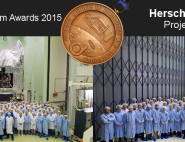Herschel sees budding stars and a giant, strange ring
The Herschel Space Observatory has uncovered a weird ring of dusty material while obtaining one of the sharpest scans to date of a huge cloud of gas and dust, called NGC 7538. The gigantic ring structure is situated at the center-top of this image. The odd ovoid possesses the mass of 500 suns, with its long axis spanning about 35 light-years and its short axis about 25 light-years.
![]()
A weird ring of dusty material seen while Herschel scanned a huge cloud of gas and dust, called NGC 7538. The blue and green colors in this image represent 70- and 160-micron data, respectively, from Herschel's Photoconductor Array Camera and Spectrometer (PACS) instrument. The red colors are 250-micron observations obtained from Herschel's Spectral and Photometric Imaging Receiver (SPIRE) instrument. Image credit: ESA/NASA/JPL-Caltech/Whitman College
Astronomers often see ring and bubble-like structures in cosmic dust clouds. The strong winds cast out by the most massive stars, called O-type stars, can generate these expanding puffs, as can their explosive deaths as supernovas. But no energetic source or remnant of a deceased O-type star, such as a neutron star, is apparent within the center of the ring. It is possible that a big star blew the bubble and, because stars are all in motion, subsequently left the scene, escaping detection.
Related Publication:
"Herschel reveals massive cold clumps in NGC 7538." C. Fallscheer, et al. C. Fallscheer et al. 2013 ApJ 773 102 The Astrophysical Journal Volume 773 Number 2. doi:10.1088/0004-637X/773/2/102
Read the news on NASA's website


